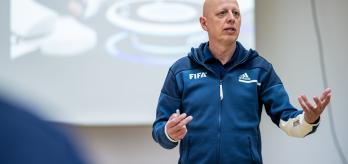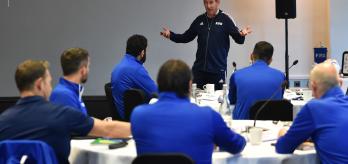Learning
-
Future challenges for technical directors
-
How the structure of technical departments may change
-
The importance of relationship-building and communication
-
Developing a bespoke plan for the future of the women’s game
Shared leadership models
As the role and responsibilities of technical directors continue to grow, alternative leadership structures may be required to guide the evolving activities of technical departments.
“When you just have one technical director it may be too much,” says Mauricio Marques, FIFA Technical Leadership expert, who believes a ‘panel of experts’ could provide effective leadership in areas such as coach education, player development and amateur football. “Instead of one technical director, there should be a variety of experts all of whom have some autonomy.”
Shared technical leadership is the adopted model in Switzerland where the traditional role of the technical director is split into three areas. “We don’t have one technical director, we have three,” says Patrick Bruggmann, Director of Football Development at the Swiss FA. “We have one for the men’s national teams - from the youth teams to the A team - and we have one technical director for women’s football. In between, that’s my position”.
Bruggmann’s role covers grassroots, refereeing, and coach education. By increasing the number of people involved in leadership the decision-making and problem-solving process is collaborative. “There are more brains involved,” explains Bruggmann. “Which maybe helps us to think from different points of view, to look at problems or solutions a little bit differently and to find solutions together,” he says. “In all roles, I think it’s very important to have other minds who give their input. There should be other brains that come with the right questions at the right moment.”
Strong relationships & communication help build effective teams
Developing effective leadership teams involves building strong relationships and trust.
“I think leadership is about teams, it’s not about a sole individual” says Jayne Ludlow, FIFA Technical Leadership Expert. “For me, leadership is a very different thought process to one I may have had five or six years ago. I’m now seeing the positive reward of leadership teams and how effective teams can be when they work well together. But to get those environments, it takes a lot of work and building relationships plays a huge part in that.”
Regular and timely communication is a key part of building trust and relationships. “We live in a really fast moving world and with so many technology platforms, people share their lives and information at real time,” says Lili Bai, Head of Women’s Football at the Asian Football Confederation (AFC). “Even in our technical work, I think people also expect quick responses and for us to use social media for knowledge sharing.”
Understanding how to utilise the latest communication methods will be key for the technical director of the future, believes Bai. “As technical leaders we really need to prepare ourselves for the future,” she says. “We must be proactive, think ahead and also respond quickly and precisely. It’s going to be a demanding and challenging job for us in the future and we need to prepare for that.”
We must be proactive, think ahead and also respond quickly and precisely. It’s going to be a demanding and challenging job for us in the future and we need to prepare for that.
Utilising all relevant communication channels can help technical directors to “sell the product” they have, says Jacquie Shipanga, Technical Director of Namibia Football Association. “As a technical leader you need to engage the media,” explains Shipanga. “You need to go out and not only talk within the member association, but to sell your association and sell the product that you have to the outside world. Communication skills and speaking to camera might be a challenge for some technical directors, but these are some of the skills that we have to equip ourselves with for the future.”
Develop a bespoke plan for the women’s game
With the women’s game growing around the globe, technical leaders should develop bespoke plans to nurture, grow and protect the future of the women’s game. “I think the future of the women’s game looks super exciting,” says Kay Cossington, former Women’s Technical Director at the English FA. “As part of this, we’re really keen to hold onto the fabric and essence of what’s important in the women’s game. We have done a piece of work with Owen Eastwood (consultant) around our history and our identity, which is uniquely different to that of the men’s game. It’s about the principle and higher purpose that we really buy into in the women’s game.”
With the women’s game growing rapidly in England, protecting player welfare is another key priority, says Cossington. “In England, we’re in a really wonderful point of tension with a game that’s going from being amateur to professional,” she explains. “There’s some real nuances around that including player welfare. There are some really core things that we think are important that we want to keep hold of and that involves putting the player at the centre of everything that we do and making sure that we build gradually and slowly.”
“But it’s our responsibility as guardians of the game that we meet the needs and demands of the women’s game and stay true to the fabric of what’s important to us. I think it’s an exciting point for any young girl or woman across the world that’s playing the sport. But I think it’s a responsibility to keep hold of what’s important as we grow within this next chapter of the women’s game.”





